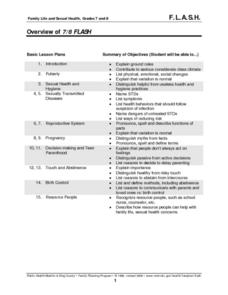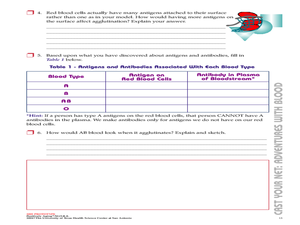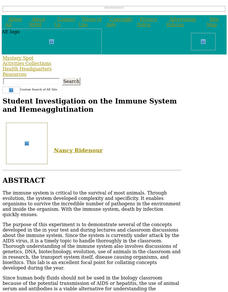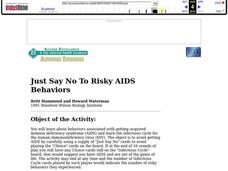Howard Hughes Medical Institute
Ebola: Disease Detectives
How did the Ebola virus first infect humans? Young virologists examine genetic sequences from the 2014 Sierra Leone outbreak to find similarities during a riveting activity. Following similar methods used by MIT and Harvard, partners...
College Board
2014 AP® Biology Free-Response Questions
The most popular AP science exam, Biology, also maintains the highest passing rate. The College Board releases old test questions covering trichomes and much more, along with statistics and scoring guidelines to help scholars study for...
Healthy Native Youth
Chapter 4: Learning About Disease
Communicable diseases are the focus of a lesson that primarily uses discussion, a hands-on activity, and a worksheet to drive their point home. Lotion and glitter create a strong visual for communicable diseases. A practice page provides...
Nemours KidsHealth
Germs: Grades 9-12
Beware the bugs! Two activities engage high schoolers in the study of germs, what they are, what they do to the body, and what can be done to prevent them from spreading. After reading a series of related articles, groups create a...
Children’s Hospital of Philadelphia
Case Study: The 1918 Influenza Pandemic – Factors Beyond the Biological that Influence the Spread of Disease
A very timely activity looks at the social and political factors that affect the spread of disease. Using the 1918 Influenza Pandemic as a case study, pupils research factors that influenced the spread of the disease, including the role...
Nemours KidsHealth
Food Allergies: Grades 6-8
Over two lessons, scholars use articles and discussions to define what a food allergy is and identify the most common food allergens. Small groups prepare a skit showcasing how the body exhibits an allergic reaction. Learners examine...
Exploratorium
Skin Shield - Explore the Body’s First Line of Defense Against Pathogens
Make pathogens and the body's defense systems come alive for young biologists in a hands-on activity. Investigators model the skin's protection against infection by observing and comparing changes in a punctured tomato and an intact...
Nemours KidsHealth
HIV and AIDS: Grades 9-12
Two activities help high schoolers learn about HIV and AIDS. First, groups read and discuss articles that provide information about sexually transmitted diseases and conduct further research to gather current information. They then...
Curated OER
Protecting the Herd
Students simulate the spread of a fictitious disease using an internet-based simulation. For this biology lesson, students predict the factors that could affect epidemic. They investigate these prediction using computer simulation.
Curated OER
"Asthma: Stopping Attacks Before They Start"
Students study facts about living with asthma. They examine medical treatments and lifestyle changes that can improve the life of asthmatics. They determine the cause and effect relationship.
Curated OER
Mechanisms to Fight Disease
Pupils explain how our body fight diseases. In this biology lesson, students identify the role of bacteria and viruses in human illness. They create a PowerPoint presentation and essay at the of the unit.
Curated OER
FLASH
Students Distinguish among assertive, aggressive, passive and manipulative behaviors,Describe consequences of each,Formulate an assertive request,Describe how it feels to risk rejection. Students Describe how human immunodeficiency virus...
Curated OER
Blood Concept Map
In this blood worksheet, students complete a concept map of the blood, the components of the blood, the cells of the immune system in the blood, homeostasis and the inflammatory reaction.
Curated OER
Antibody Center Template
In this antibodies worksheet, students use model diagrams of antigens, antibodies and blood cells to develop a visual understanding of the immune system. They draw diagrams of antibodies and antigens attached to each other and answer...
PBS
Ebola Outbreak
As of April, 2016, more than 28,000 suspected cases of Ebola were recorded in Western Africa with over 11,000 human deaths. Classes discuss the Ebola virus outbreak in 2014 and then groups develop an action plan based on...
Curated OER
Student Investigation on the Immune System and Hemeagglutination
Students study laboratory protocol for hemagglutination experiments.
Curated OER
STDs
In this biology activity, students identify and locate various vocabulary terms pertaining to types of STDs. There are 42 biology terms located in the word search.
Curated OER
Health and Safety
Students identify the colors used in a preschool classroom, the set-up, the safety procedures, as well as the immunizations required for a preschool. They also engage in small activities that include a class discussion, note taking, and...
Curated OER
Communicable Disease
Students use Palms, or handheld computers, and the Cooties software to enact the transmission of communicable diseases. They discuss incubation and immunity and collect and interpret data and figure out who was the "carrier "of a "disease."
Curated OER
When Germs Attack!
Students explore the hidden world of microbes and how our bodies spring into action in response to diseases. This ten lesson unit presents data on several microbial diseases and the reaction of the body's immune system.
Curated OER
Waterborne Diseases
Students compare symptoms of several well-known water-borne diseases. They use the symptoms and background information on the disease to explain some of the aspects in terms of immune response.
Curated OER
Exploring Vaccines
Students explain in a written format how vaccination works and how it draws upon the natural immunity. They differentiate between vaccinations and immunizations. Students identify a number of illnesses that can be prevented by the use of...
Curated OER
Just Say No To Risky Aids Behaviors
Students discover the behaviors associated with getting acquired immune deficiency syndrome (AIDS) and study the infectious cycle for the human immunodeficiency virus (HIV) by playing a board game. They play in small groups.
Curated OER
Disease and Epidemics
Students explore how the study of diseases, epidemics and disease management offers opportunities for exploration of biological evolution, immune systems, interaction between humans and their environment, and interaction among organisms....

























